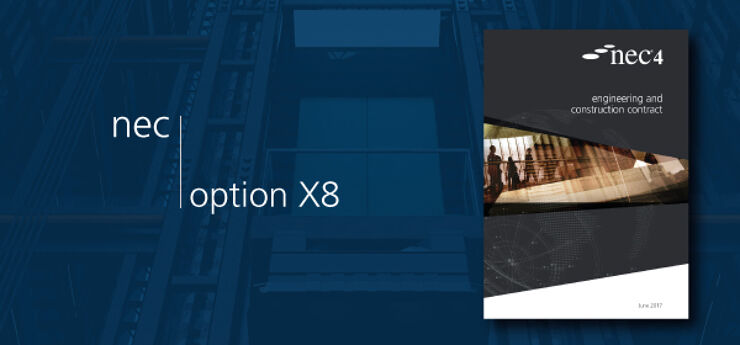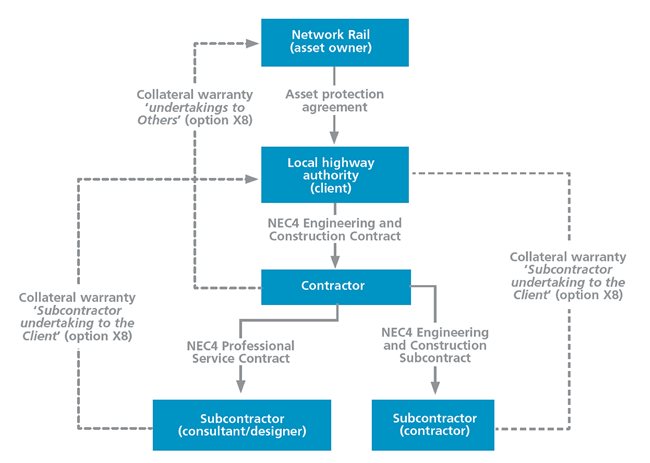
Collateral warranties and rights of third parties are an important yet frequently misunderstood aspect of construction contracts. Although not a key part of an NEC project manager’s day-to-day role, a basic understanding of these topics is vital and clients should always seek competent advice when preparing a contract.
Use of collateral warranties
A collateral warranty gives rights to a client or third party which would not otherwise have direct contractual rights. In NEC4 contracts, collateral warranties can be made part of the contract using secondary option X8 on undertakings.
A collateral warranty is a separate promise made to a client or third party (the beneficiary) by a contractor or subcontractor (the warrantor) that they will perform their contractual obligations. The warranty is therefore said to be ‘collateral’ as it sits alongside the relevant contract. The beneficiary will usually have an interest in the asset for which contracted work or service is being performed.
The requirement for a collateral warranty may be a condition of a separate agreement. For example, a local highways authority undertaking road bridge works under an asset-protection agreement with Network Rail may be required to obtain collateral warranties from its design-and-build contractor in favour of Network Rail. Furthermore, the highways authority may require undertakings from the contractor’s designers and subcontractors to protect itself in the event the contractor becomes insolvent or to extend the benefit of designer’s duty of care.
Figure 1 shows how the collateral warranties would operate in the above example using an NEC4 Engineering and Construction Contract (ECC) main contract, NEC4 Professional Service Contract (PSC) design subcontract and NEC4 Engineering and Construction Subcontract (ECS) works subcontract.
 NEC option X8 and its use Option X8 is available for use with all NEC4 long-form contracts except the Supply Contract (SC), Design Build and Operate Contract (DBO) and Alliance Contract (ALC). ECC option X8 enables collateral warranties to be given by the contractor to ‘Others’, which is a defined term meaning third parties (ECC clause 11.2(12)), or by the subcontractor to the client or others. The names of the beneficiaries and the works relating to the warranty need to be stated in contract data part one, and the form of undertaking (i.e. collateral warranty) must be provided in the scope.
NEC option X8 and its use Option X8 is available for use with all NEC4 long-form contracts except the Supply Contract (SC), Design Build and Operate Contract (DBO) and Alliance Contract (ALC). ECC option X8 enables collateral warranties to be given by the contractor to ‘Others’, which is a defined term meaning third parties (ECC clause 11.2(12)), or by the subcontractor to the client or others. The names of the beneficiaries and the works relating to the warranty need to be stated in contract data part one, and the form of undertaking (i.e. collateral warranty) must be provided in the scope.
It should be noted that PSC option X8 does not provide for undertakings by subcontractors. So, when using a PSC for early contractor involvement on a design and build project, a client requiring a collateral warranty from the contractor’s designer during the preconstruction stage would need to add a Z clause to this effect in the PSC.
Collateral warranty agreements are normally executed after the main contract has come into existence. Option X8 requires the client to prepare the warranties and send them to the contractor (ECC) or consultant (PSC) for signature within 3 weeks, though failure to provide a collateral warranty is not listed in clause 91 as a reason for termination (unlike a bond or guarantee, reason R12). Option X8 is silent on limitation period, so reliance will need to be made on the wording of the warranty. Recent English case law supports the position that the end of the liability period runs from completion of the whole of the works (Swansea Stadium Management Company Limited v. City & County of Swansea, Interserve Construction Limited [2018] EWHC 2192).
NEC does not provide standard forms of collateral warranty. However, the UK Construction Industry Council (CIC) has produced a range of standard warranties for use in England, Scotland and Wales. If using the CIC forms or any other forms, it is important to ensure consistency with the main and sub-ordinate contracts, remembering the unique drafting convention adopted by NEC contracts.
The Y(UK)3 alternative
NEC secondary option Y(UK)3 offers an alternative way for parties to give third-party rights. This invokes the UK Contracts (Rights of Third Parties) Act 1999 (‘the Act’), section 1 of which allows people who are not party to a contract to enforce a term of the contract if the contract expressly states they may.
If Y(UK)3 is used, the term(s) of the contract that may be enforced under the Act and the beneficiary must be stated in contract data part one. On the other hand, if the contracting parties wish expressly to exclude third-party rights being conferred under the Act, they should select Y(UK)3 and state ‘none’ in the contract data entry for the term and beneficiary.
The Act provides a simpler alternative for conferring third-party rights as it avoids the need to prepare and execute separate collateral warranties. But it has yet to become popular with NEC clients and their legal advisors due to concerns about the Act’s provisions covering step-in rights and lack of case law.
A recent Court of Appeal decision (Chudley v. Clydesdale Bank plc [2019] EWCA Civ 344) upheld a ruling that a beneficiary does not need to be named and can be stated by ‘class’ only, which may give clients more confidence. Option Y(UK)3.3 allows beneficiaries to be identified by class but requires the client to notify the contractor as soon as its name has been identified.




